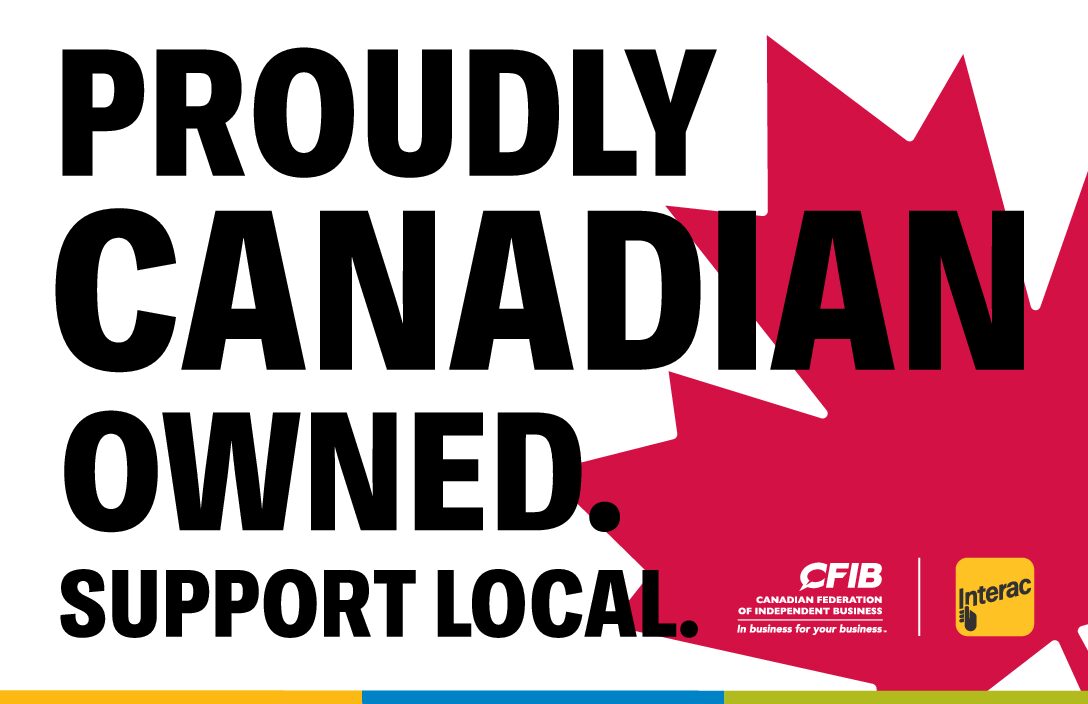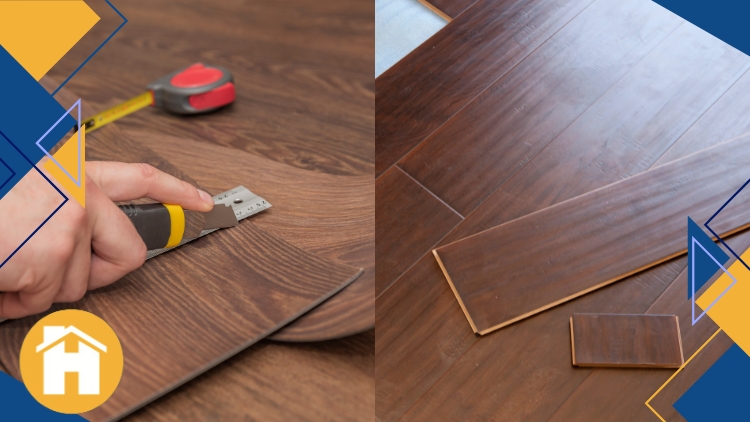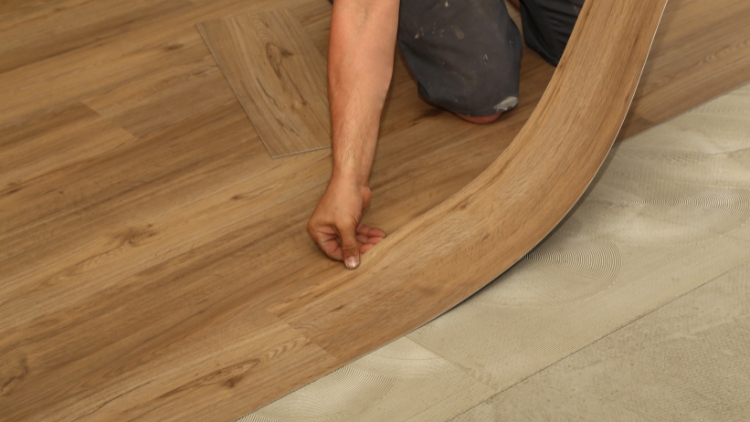We offer a wide range of services for that fresh look, or just maintenance or updates to keep your home functioning and safe. Regardless of the size of the job, we have a craftsman that can tackle it. We offer a wide range of services for that fresh look, or just maintenance or updates to keep your home functioning and safe. Regardless of the size of the job, we have a craftsman that can tackle it.

Flooring / May 19, 2024

Stepping into a newly renovated space, the floor beneath your feet is not just a surface but a statement—a reflection of your style and a testament to practical decision-making. As you weigh the options between the sleek durability of vinyl flooring and the timeless appeal of laminate, expert guidance is paramount. Enter our trusted experts in handyman services in Waterloo— seasoned professionals who merge craftsmanship with savvy renovation insights.
They’ll navigate you through the intricacies of how to install laminate flooring, ensuring every plank resonates with both elegance and efficiency. Or, perhaps you’ll find the allure of low-maintenance, water-resistant vinyl aligns perfectly with the rhythm of your daily life. In the world of renovations, your flooring choice sets the stage for years to come, and with the right handyman as your guide, that stage is set for total satisfaction.
At Handyman Connection, we understand the flooring world can be complex, requiring knowledge about the different types of floors, their components, and how they differ.
Laminate, for instance, is a multi-layer synthetic product. The four main components of laminate is a bottom layer for moisture resistance, a core layer made of high-density or medium-density fibreboard, a decorative layer with a high-resolution photo of real wood or stone, and a top layer that provides wear resistance and durability.
Vinyl, on the other hand, consists of either one or multiple layers. The base layer is typically made of fibreglass which is coated in PVC vinyl and a plasticizer. This is then printed and embossed with a surface print layer, and covered with one or more wear layers, including a top coat known as the “mil layer” which defines the flooring’s durability.
Both types of flooring stunningly mimic the natural looks of hardwood or stone but differ in their core makeup; laminate is more akin to compressed wood while vinyl is entirely synthetic. Understanding these basic components provides a solid foundation for your flooring choice.
When it comes to durability, both laminate and vinyl offer robust performance that withstands daily wear and tear. However, slight differences emerge depending on your specific needs.
Laminate is constructed from a composite wood base, topped with a high-resolution photographic image. It’s then sealed with a clear protective layer to resist damage. It is particularly beneficial for resistance to scratches and dents, which makes it an ideal choice for high-traffic areas, homes with pets, or families with children.
On the other hand, vinyl, especially luxury, excels in water resistance. It’s a great material for moisture-prone areas like kitchens, bathrooms, and below-grade basements. Vinyl’s ability to resist water damage also makes cleaning spills easy, making it an excellent choice for active households.
Essentially, if high-impact resistance is a priority, laminate would likely serve you best. But if you need flooring that maintains its integrity even in damp conditions, then vinyl emerges as the winner in this durability showdown.

Another important factor to consider when choosing between laminate and vinyl is cost. Both options are usually more affordable than traditional hardwood, but there are some variations in their respective expenses.
Laminate is generally more cost-effective to purchase upfront, mainly because it’s made from relatively inexpensive materials. Furthermore, if you’re a handy type, you may even be able to install it yourself, potentially saving on installation costs.
In contrast, while vinyl may cost slightly more initially than former, its lifespan and durability can often make it a more economical choice in the long run. This is especially true for luxury vinyl, which can look and perform comparably to more pricey natural materials, like stone or wood.
Therefore, while laminate may offer an attractive low upfront cost, vinyl flooring provides valuable longevity. Your final choice should consider both initial outlay and potential long-term expense.
When considering the ease of installation, both types have their unique advantages and challenges. However, understanding these aspects will help you make an optimal decision that matches your home improvement skills and project timeframe.
Laminate, renowned for its simple click-lock installation system, can be a great choice for the adventurous DIY enthusiasts out there. Typically, the planks have a tongue and groove system that allows the pieces to fit together neatly like puzzle pieces. Additionally, it does not require any special tools or adhesives for its installation. It’s worth noting, though, that laminate floor installation does require a bit more time and patience, as you’ll need to carefully line up each board and make sure it clicks into place securely.
On the other hand, vinyl offers even more simplicity in its installation. With options for peel-and-stick, glue-down, or click-lock designs, vinyl can be an ideal pick for individuals looking for a quick and straightforward setup. The most beginner-friendly among these options is undoubtedly the peel-and-stick design, which requires only a clean, smooth surface to adhere to. Vinyl’s flexible nature makes it even easier to lay down, especially in rooms with unusual or complicated layouts.
While these floor types offer human-friendly installation, they do require different surface preparation. For instance, laminate requires a clean, flat, and dry subfloor, while vinyl needs a smooth finish to avoid imperfections showing through the material.
When it comes to ease of installation, both laminate and vinyl present viable options depending on your skill level, project timeline, and room layout. Don’t let the process intimidate you; with careful planning, the right tools and a bit of patience, you can achieve a successful installation with either material.
When you’re considering a flooring renovation, don’t leave the success of your project to chance. Instead, place your trust in the experts at Handyman Connection. No matter if you choose laminate or vinyl, our skilled professionals are equipped with the knowledge and tools to ensure the result meets your highest expectations.
At Handyman Connection, we understand that every successful flooring project begins with thorough preparation and planning. Our team takes the time to assess each detail of your unique space, offering advice on the best materials to meet your design goals, practical needs, and budget constraints.
Our trusted experts oversee every aspect of your installation, from meticulously preparing the subfloor to perfecting the placement of each vinyl or laminate piece. We are committed to delivering a seamless finish, minimizing disruption in your home, and leaving you completely satisfied.
With Handyman Connection, your flooring venture isn’t just about a functional upgrade; we see it as an opportunity to add beauty and value to your home. Hence, our team doesn’t just install; we bring a passion for craftsmanship, precision, and excellent customer service to every flooring project.
Whether you choose the charm of laminate or the contemporary appeal of vinyl, know that partnering with Handyman Connection for your flooring overhaul in Waterloo means choosing peace of mind. Get in touch with us today, and take the first step towards the transformation you’ve always desired.